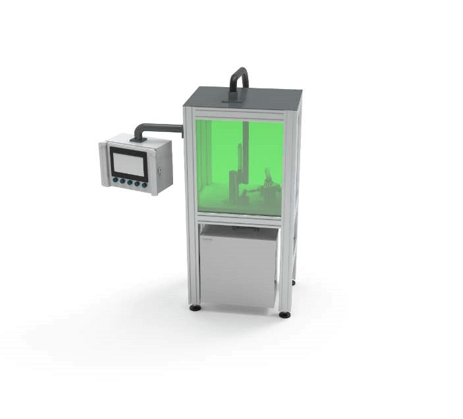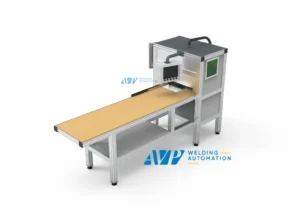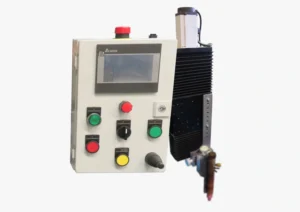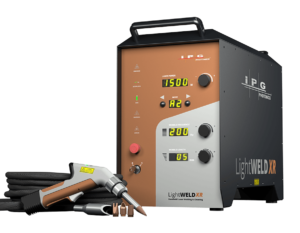Automated laser welding has become a key element of modern industry, offering exceptionally high-quality welds, increased productivity, and optimization of the entire production process. While it is often primarily associated with longitudinal and circumferential welds, its applications extend far beyond that. Laser welding can be integrated into fully automated production cells, where, in addition to welding, processes such as automated assembly, cleaning, and even polishing of final products take place.

In 2024, AVP introduced the integration of manual laser welding torches into automated welding processes. This solution enables outstanding weld quality at significantly lower costs than robotic systems (robotic laser torches), providing companies with cost-effective automation without compromising quality.
Another key advantage of this approach is its increased flexibility: while robotic welding systems had to operate continuously (at least 8 hours per day) to remain cost-effective, the manual laser welding torch allows for more versatile use. Even when the welding cell is not in operation, the torch can be removed, and the power source can be used for manual welding in another workshop. This flexibility was previously unavailable with traditional robotic solutions.
Indexing Tables in Welding Cells
One of the most common components in laser welding cells is the indexing table (rotary positioning unit). These enable automated welding and the precise positioning of workpieces in multiple orientations, at the same time optimizing production and improving accuracy. Each position can be designated for a specific process, such as one station for assembly and another for welding. In automatic mode, the indexing table rotates workpieces to the next welding position, while in manual mode, it allows flexible adjustments for specialized welding operations, such as correcting individual components.
Most automatic welding cells are equipped with sensors that temporarily pause the cycle under predefined conditions. This allows welding cells to operate autonomously, stopping automatically when no workpieces are available or when required for operational reasons.
Key Components of an Automated Welding Cell
Modern laser welding cells are designed for maximum efficiency and flexibility. The most critical components include:
- Automated workpiece feeding – Ensures a continuous welding process without the need for manual loading of each workpiece. Semi-automated systems also exist, where operators only load the workpieces while all subsequent processes run automatically. The configuration always depends on operational requirements and economic feasibility.
- Pneumatic clamping systems – Provide stable and precise fixation of workpieces during movement or welding.
- Laser cleaning before and after welding – Removes oxides and contaminants to ensure optimal weld quality and a clean appearance.
- Automated ejection/removal of welded parts – Improves production flow and minimizes manual handling.
- Protective enclosure with viewing window – Ensures operator safety while allowing process monitoring. These are always compliant with the local laws and directives.
- Local fume extraction and filtration systems – Reduce exposure to smoke and dust in the work environment.
Who Benefits from Automated Laser Welding Systems?
Automated laser welding systems are ideal for companies looking to increase production efficiency, reduce labor costs, and maintain the highest weld quality. Laser welding is particularly crucial in the pharmaceutical and food industries, where strict hygiene standards and precise process repeatability are required. Due to these high standards, more companies in these industries are turning to automated solutions. However, in certain applications, TIG welding remains preferable, which is why it is often integrated into welding cells.
Laser welding machines are also well-suited for the mass production of exhaust systems, pressure vessels, automotive components, and other metal structures. Additionally, they are indispensable in the aerospace and medical industries, where extremely high repeatability and precision are required.
Automated laser welding is not just the future—it is already setting new industry standards, helping companies remain competitive in an increasingly advanced technological landscape.
Sustainability in Automation
The implementation of automated welding cells contributes to reducing the ecological footprint by optimizing material use and minimizing waste. Automated systems enable precise control over gas consumption, energy usage, and consumable materials, significantly reducing environmental impact. Modern control systems allow real-time monitoring of resource consumption and immediate adjustments to further enhance energy efficiency. Combined with closed fume extraction systems, these solutions significantly reduce emissions in the workplace and the environment—an increasingly important factor in the industry.
Workplace Safety in Production
The introduction of automated welding cells significantly improves workplace safety by replacing manual tasks with machine-controlled processes. The cells feature fully enclosed protective enclosures that prevent direct operator contact with moving parts and welding areas. In addition to physical safety, modern welding cells are equipped with advanced security features such as light curtains and presence sensors, which immediately halt operations if an unauthorized person enters the workspace. Fume extraction and air filtration systems ensure a clean and safe working environment, protecting employee health. Automation also significantly reduces the risk of workplace accidents and injuries.
Energy Efficiency
Automated welding cells are designed to minimize energy consumption. A key advantage is the precise control of individual components—electric drives for indexing tables, pneumatic clamps, and vacuum systems operate only when necessary, preventing unnecessary energy use. Additionally, modern control systems optimize movement sequences to reduce idle times and maximize efficiency. This results in higher productivity and lower energy costs—an especially important factor for large-scale production lines.



